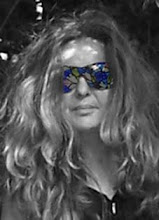Aquí, arriba,
las grietas de los edificios se rellenan con pulpa de luz luna machacada.
Toda la sombra del hombre no es mayor que la de su sombrero.
Yace a sus pies como un pedestal circular para una muñeca,
Y él es un alfiler invertido con la punta magnetizada hacia la luna.
No ve la luna; solo observa sus vastas propiedades,
siente su extraña luz sobre las manos, ni caliente ni fría,
de una temperatura imposible de registrar en los termómetros.
Pero cuando el Hombre Polilla
hace sus raras aunque ocasionales visitas a la superficie,
la luna le parece muy distinta. Él emerge
desde una rendija bajo el borde de una de las aceras
y nervioso comienza a escalar las fachadas de los edificios.
Cree que la luna es un pequeño hueco en lo alto del cielo,
lo que corrobora que el cielo como protección
resulta inútil.
Tiembla, pero debe descubrir hasta dónde puede escalar.
Por las fachadas,
arrastrando tras él su sombra como el paño de un fotógrafo
escala con miedo, pensando que esta vez sí logrará
introducir por completo su pequeña cabeza en el hueco redondo
y atravesarlo, arrastrado a través de un tubo de volutas negras en la luz.
(El hombre, inmóvil debajo de él, no se hace demasiadas ilusiones.)
Pero el Hombre Polilla debe hacer lo que más teme, aunque
fracase, por supuesto, y caiga de nuevo asustado sin apenas lastimarse.
Después vuelve
a los pálidos subterráneos de cemento a los que llama
casa. Revolotea,
aletea, y no sube en los trenes silenciosos
con la rapidez que debería. Las puertas se cierran
deprisa.
El Hombre Polilla se sienta siempre en sentido contrario
y el tren arranca inmediatamente, a toda velocidad,
sin cambiar de marchas ni moverse poco a poco.
No puede calcular la velocidad a la que viaja hacia atrás.
Cada noche debe
viajar de túneles artificiales y tener sueños recurrentes.
como las traviesas se repiten bajo el tren, éstos se repiten por debajo
de su mente agitada. No se atreve a mirar por la ventana,
porque el tercer raíl, la intacta corriente de veneno,
pasa a su lado. La mira como a una enfermedad
cuya propensión ha heredado. Debe que llevar
las manos en los bolsillos, como otros deben llevar bufandas.
Si lo alcanzas,
acércale una linterna a los ojos. Sólo son pupila negra,
una noche en sí mismos, cuyo horizonte de vetas se contrae
cuando devuelve la mirada y cierra los ojos.Luego, de los párpados
se desliza una lágrima, su única posesión, como aguijón de abeja. .
Furtivamente la atrapa, y cuando no prestas atención
se la traga. Pero si miras, la entregará,
fresca como surgida de los manantiales subterráneos y tan pura
como para ser bebida.
Elizabeth Bishop “The Man-Moth” from The Complete Poems 1926-1979.
The Man-Moth
The Man Moth from Michael Hyland on Vimeo.
Vídeo basado en el poema "El hombre polilla" dirigido por Sonny MalhotraHere, above,
cracks in the buildings are filled with battered moonlight.
The whole shadow of Man is only as big as his hat.
It lies at his feet like a circle for a doll to stand on,
and he makes an inverted pin, the point magnetized to the moon.
He does not see the moon; he observes only her vast properties,
feeling the queer light on his hands, neither warm nor cold,
of a temperature impossible to record in thermometers.
But when the Man-Moth
pays his rare, although occasional, visits to the surface,
the moon looks rather different to him. He emerges
from an opening under the edge of one of the sidewalks
and nervously begins to scale the faces of the buildings.
He thinks the moon is a small hole at the top of the sky,
proving the sky quite useless for protection.
He trembles, but must investigate as high as he can climb.
Up the façades,
his shadow dragging like a photographer’s cloth behind him
he climbs fearfully, thinking that this time he will manage
to push his small head through that round clean opening
and be forced through, as from a tube, in black scrolls on the light.
(Man, standing below him, has no such illusions.)
But what the Man-Moth fears most he must do, although
he fails, of course, and falls back scared but quite unhurt.
Then he returns
to the pale subways of cement he calls his home. He flits,
he flutters, and cannot get aboard the silent trains
fast enough to suit him. The doors close swiftly.
The Man-Moth always seats himself facing the wrong way
and the train starts at once at its full, terrible speed,
without a shift in gears or a gradation of any sort.
He cannot tell the rate at which he travels backwards.
Each night he must
be carried through artificial tunnels and dream recurrent dreams.
Just as the ties recur beneath his train, these underlie
his rushing brain. He does not dare look out the window,
for the third rail, the unbroken draught of poison,
runs there beside him. He regards it as a disease
he has inherited the susceptibility to. He has to keep
his hands in his pockets, as others must wear mufflers.
If you catch him,
hold up a flashlight to his eye. It’s all dark pupil,
an entire night itself, whose haired horizon tightens
as he stares back, and closes up the eye. Then from the lids
one tear, his only possession, like the bee’s sting, slips.
Slyly he palms it, and if you’re not paying attention
he’ll swallow it. However, if you watch, he’ll hand it over,
cool as from underground springs and pure enough to drink.
Elizabeth Bishop, “The Man-Moth” from The Complete Poems 1926-1979.
'Man-Moth Merz' from phil archer on Vimeo.
Animation by Suzie Hanna, soundtrack by Phil Archer. Based on a poem by Elizabeth Bishop,























No hay comentarios:
Publicar un comentario